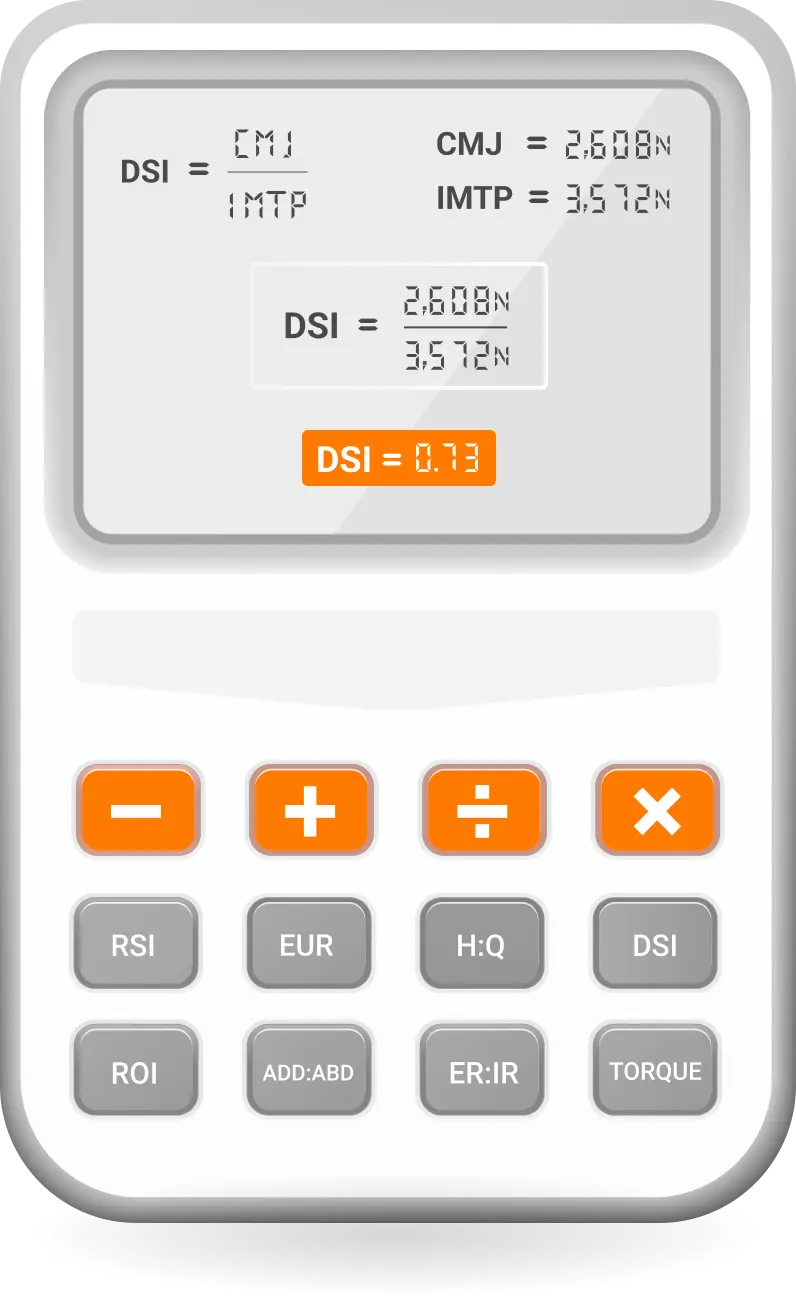MSK
Calculators
+ Calculate common musculoskeletal metrics and indexes.
÷ Compare values to evidence-based benchmarks.
× Determine asymmetries and ratios from isolated tests.
= Simple tools for calculating key movement metrics.
DSI

The Dynamic Strength Index is a ratio of ballistic strength and maximal isometric strength that can be used to guide programming decisions.
- Newtons
- Pounds
- Kilograms
Learn more about DSI research, application and how to generate a DSI report in VALD Hub.
ROI






Enter your business’ numbers and desired investment value to calculate your potential Return on Investment.
Click here to learn more about ROI from the VALD Practitioner’s Guide to ROI.
Force-Rate Ratio




Compare peak force values from two conditions: one emphasizing maximal force and the other emphasizing rate of force development.
- Newtons
- Pounds
- Kilograms
Learn from sport science leaders about peak force and rate of force development as integral parts of assessment.
Speed

Input split times for a given distance to determine average speed.
- Meters
- Yards
Find more information on setting up your timing gates for a flying 10m sprint.
Impact Index

Assess impact loads relative to body weight and functional capacity for daily activities (e.g. step navigation) with the Impact Index calculator.
- Double Leg
- Single Leg
Find more information on the impact index in the VALD Practitioners Guide to ACL.
Load Conversion




Quickly convert Newtons, Pounds and Kilograms to easily apply testing data in a more digestible format.
EUR

The Eccentric Utilization Ratio compares jump performance from the countermovement jump and squat jump to assess efficiency of the stretch-shortening cycle.
- Centimeters
- Meters
- Inches
Learn more about assessing and applying the EUR from Jo Clubb and Global Performance Insights.
Joint Ratio


Assess the balance between agonist and antagonist muscle strength, such as shoulder ER/IR, hamstrings : quadriceps, and hip AD/AB ratios.
MVIC: Maximal Voluntary Isometric Contraction
- Newtons
- Pounds
- Kilograms
Torque



Assess isolated capacity of a joint to better compare your clients to research-based benchmarks.
- Absolute
- Body Mass Normalized
Understand the key applications of torque during knee rehabilitation from Erik Meira.
Asymmetry





Select from a variety of kinetic and kinematic metrics to quantify client asymmetry percentages for important rehab and performance values.
- VALD Asymmetry Formula
- Limb Symmetry Index
- Symmetry Index
Explore an in-depth explanation of various asymmetry calculation methods.
Relative Strength




Assess peak force normalized to your subjects’ bodyweight to better compare strength values across individuals and groups
- Metric
- Imperial
Find more information about how relative peak forces are applied, in Alex Natera's Run-Specific Isometrics blog.
Distance Conversion



Quickly convert distances and heights to easily apply testing data in a more digestible format.



